Industrial Organic Wastewater through Drip Irrigation to Reduce Chemical Fertilizer Input and Increase Use Efficiency by Promoting N and P Absorption of Cotton in Arid Areas
Abstract
:1. Introduction
2. Materials and Methods
2.1. Experimental Site Description
2.2. Experimental Design
2.3. Data Collection
2.3.1. Soil Properties
2.3.2. Cotton Nutrient Absorption
2.3.3. Accumulation of Trace Elements in Cotton Plant
2.3.4. Cotton Yield
2.3.5. Fertilizer Utilization Efficiency
2.4. Data Analysis
3. Results
3.1. Soil Nutrients
3.2. Absorption and Distribution of N, P and K
3.3. Absorption and Distribution of Ca, Mg and S
3.4. Absorption and Distribution of Cu, Zn, Mn, Fe and B
3.5. Cotton Yield and Fertilizer Utilization Rate
3.6. Correlation Analysis
4. Discussion
4.1. Effect of Organic Wastewater with Chemical Fertilizers on N, P and K Absorption
4.2. Synergistic Effect of Mn and Fe and the Increased Absorption of N, P and K
4.3. Mechanisms of Cotton Yield and Fertilizer Utilization Efficiency
5. Conclusions
Author Contributions
Funding
Data Availability Statement
Conflicts of Interest
References
- Feng, L.; Dai, J.; Tian, L.; Zhang, H.; Li, W.; Dong, H. Review of the technology for high-yielding and efficient cotton cultivation in the northwest inland cotton-growing region of China. Field Crops Res. 2017, 208, 18–26. [Google Scholar] [CrossRef]
- Wang, Y.; Peng, S.; Huang, J.; Zhang, Y.; Feng, L.; Zhao, W.; Qi, H.; Zhou, G.; Deng, N. Prospects for cotton self-sufficiency in China by closing yield gaps. Eur. J. Agron. 2022, 133, 126437. [Google Scholar] [CrossRef]
- Ma, K.; Wang, Z.; Li, H.; Wang, T.; Chen, R. Effects of nitrogen application and brackish water irrigation on yield and quality of cotton. Agric. Water Manag. 2022, 264, 107512. [Google Scholar] [CrossRef]
- Li, N.; Lin, H.; Wang, T.; Li, Y.; Liu, Y.; Chen, X.; Hu, X. Impact of climate change on cotton growth and yields in Xinjiang, China. Field Crops Res. 2020, 247, 107590. [Google Scholar] [CrossRef]
- Jing, J.; Gao, W.; Cheng, L.; Wang, X.; Duan, F.; Yuan, L.; Rengel, Z.; Zhang, F.; Li, H.; Cahill, J.F.; et al. Harnessing root-foraging capacity to improve nutrient-use efficiency for sustainable maize production. Field Crops Res. 2022, 279, 108462. [Google Scholar] [CrossRef]
- Feng, L.; Chi, B.J.; Dong, H.J. Cotton cultivation technology with Chinese characteristics has driven the 70-year development of cotton production in China. J. Integr. Agric. 2022, 21, 597–609. [Google Scholar] [CrossRef]
- Hou, X.; Xiang, Y.; Fan, J.; Zhang, F.; Hu, W.; Yan, F.; Guo, J.; Xiao, C.; Li, Y.; Cheng, H.; et al. Evaluation of cotton N nutrition status based on critical N dilution curve, N uptake and residual under different drip fertigation regimes in Southern Xinjiang of China. Agric. Water Manag. 2021, 256, 107134. [Google Scholar] [CrossRef]
- Lv, N.; Zhu, H.H.; Cheng, W.M. Feasibility study on reduction of agricultural chemical fertilizerand substitution of bio-fertilizer: An empirical study of cotton sur-vey data in Xinjiang. Geogr. Res. 2022, 41, 1459–1480. Available online: https://kns.cnki.net/kcms/detail/detail.aspx?dbname=DKFX2022&filename=DLYJ202205015&dbcode=DKFX (accessed on 25 September 2022).
- Li, S.; Lei, Y.; Zhang, Y.; Liu, J.; Shi, X.; Jia, H.; Wang, C.; Chen, F.; Chu, Q. Rational trade-offs between yield increase and fertilizer inputs are essential for sustainable intensification: A case study in wheat-maize cropping systems in China. Sci Total Environ. 2019, 679, 328–336. [Google Scholar] [CrossRef] [PubMed]
- Khan, A.; Tan, D.K.Y.; Afridi, M.Z.; Luo, H.; Tung, S.A.; Ajab, M.; Fahad, S. Nitrogen fertility and abiotic stresses management in cotton crop: A review. Environ. Sci. Pollut. Res. 2017, 24, 14551–14566. [Google Scholar] [CrossRef]
- Khan, A.; Tan, D.K.Y.; Munsif, F.; Afridi, M.Z.; Shah, F.; Wei, F.; Zhou, R. Nitrogen nutrition in cotton and control strategies for greenhouse gas emissions: A review. Environ. Sci. Pollut. Res. 2017, 24, 23471–23487. [Google Scholar] [CrossRef] [PubMed]
- Zhu, W.; Qi, L.; Wang, R. The relationship between farm size and fertilizer use efficiency: Evidence from China. J. Integr. Agric. 2022, 21, 273–281. [Google Scholar] [CrossRef]
- Liu, M.; Yang, J.; Li, X.; Yu, M.; Wang, J. Effects of Irrigation Water Quality and Drip Tape Arrangement on Soil Salinity, Soil Moisture Distribution, and Cotton Yield (Gossypium hirsutum L.) Under Mulched Drip Irrigation in Xinjiang, China. J. Integr. Agric. 2012, 11, 502–511. [Google Scholar] [CrossRef]
- Guan, C.; Ma, X.; Shi, X. The impact of collective and individual drip irrigation systems on fertilizer use intensity and land productivity: Evidence from rural Xinjiang, China. Water Resour. Econ. 2022, 38, 100196. [Google Scholar] [CrossRef]
- Ning, S.; Zhou, B.; Shi, J.; Wang, Q. Soil water/salt balance and water productivity of typical irrigation schedules for cotton under film mulched drip irrigation in northern Xinjiang. Agric. Water Manag. 2021, 245, 106651. [Google Scholar] [CrossRef]
- Wang, H.; Wu, L.; Wang, X.; Zhang, S.; Cheng, M.; Feng, H.; Fan, J.; Zhang, F.; Xiang, Y. Optimization of water and fertilizer management improves yield, water, nitrogen, phosphorus and potassium uptake and use efficiency of cotton under drip fertigation. Agric. Water Manag. 2021, 245, 106662. [Google Scholar] [CrossRef]
- Tao, R.; Hu, B.; Chu, G. Impacts of organic fertilization with a drip irrigation system on bacterial and fungal communities in cotton field. Agric. Syst. 2020, 182, 102820. [Google Scholar] [CrossRef]
- Li, B.; Shen, Y. Effects of land transfer quality on the application of organic fertilizer by large-scale farmers in China. Land Use Policy 2021, 100, 105124. [Google Scholar] [CrossRef]
- Fernandez, A.L.; Sheaffer, C.C.; Wyse, D.L.; Staley, C.; Gould, T.J.; Sadowsky, M.J. Associations between soil bacterial community structure and nutrient cycling functions in long-term organic farm soils following cover crop and organic fertilizer amendment. Sci. Total Environ. 2016, 566–567, 949–959. [Google Scholar] [CrossRef] [Green Version]
- Moe, K.; Moh, S.M.; Htwe, A.Z.; Kajihara, Y.; Yamakawa, T. Effects of Integrated Organic and Inorganic Fertilizers on Yield and Growth Parameters of Rice Varieties. Rice Sci. 2019, 26, 309–318. [Google Scholar] [CrossRef]
- Zhang, M.; Sun, D.; Niu, Z.; Yan, J.; Zhou, X.; Kang, X. Effects of combined organic/inorganic fertilizer application on growth, photosynthetic characteristics, yield and fruit quality of Actinidia chinesis cv ‘Hongyang’. Global Ecol. Conserv. 2020, 22, e00997. [Google Scholar] [CrossRef]
- Song, W.; Shu, A.; Liu, J.; Shi, W.; Li, M.; Zhang, W.; Li, Z.; Liu, G.; Yuan, F.; Zhang, S.; et al. Effects of long-term fertilization with different substitution ratios of organic fertilizer on paddy soil. Pedosphere 2022, 32, 637–648. [Google Scholar] [CrossRef]
- Zhang, J.; Bei, S.; Li, B.; Zhang, J.; Christie, P.; Li, X. Organic fertilizer, but not heavy liming, enhances banana biomass, increases soil organic carbon and modifies soil microbiota. Appl. Soil Ecol. 2019, 136, 67–79. [Google Scholar] [CrossRef]
- Pan, Y.; Guo, J.; Fan, L.; Ji, Y.; Liu, Z.; Wang, F.; Pu, Z.; Ling, N.; Shen, Q.; Guo, S. The source–sink balance during the grain filling period facilitates rice production under organic fertilizer substitution. Eur. J. Agron. 2022, 134, 126468. [Google Scholar] [CrossRef]
- Bergstrand, K.J. Organic fertilizers in greenhouse production systems—A review. Sci. Hortic. 2022, 295, 110855. [Google Scholar] [CrossRef]
- Laurent, C.; Bravin, M.N.; Crouzet, O.; Pelosi, C.; Tillard, E.; Lecomte, P.; Lamy, I. Increased soil pH and dissolved organic matter after a decade of organic fertilizer application mitigates copper and zinc availability despite contamination. Sci Total Environ. 2020, 709, 135927. [Google Scholar] [CrossRef] [PubMed]
- Sakthivel, S.; Dhanapal, A.R.; Balakrishnan, E.; Selvapitchai, S. Quantitative and qualitative analysis of bottle gourd (Lagenaria siceraria): Impact of organic liquid fertilizer. Energy Nexus 2022, 5, 100055. [Google Scholar] [CrossRef]
- Ravindran, B.; Karmegam, N.; Yuvaraj, A.; Thangaraj, R.; Chang, S.W.; Zhang, Z.; Kumar Awasthi, M. Cleaner production of agriculturally valuable benignant materials from industry generated bio-wastes: A review. Bioresour. Technol. 2021, 320, 124281. [Google Scholar] [CrossRef] [PubMed]
- Chen, J.; Jiang, X.; Zhang, Y.; Zhang, Y.; Sun, Y.; Zhang, L. Organic matter conversion and contributors to bioavailability in biogas slurry treated by biochar/persulfate during the oxidation pond process. J. Clean. Prod. 2022, 355, 131770. [Google Scholar] [CrossRef]
- Wang, Y.; Wang, S.; Yan, X.; Gao, S.; Man, T.; Yang, Z.; Ren, L.; Wang, P. Preparation of liquid bacteria fertilizer with phosphate-solubilizing bacteria cultured by food wastewater and the promotion on the soil fertility and plants biomass. J. Clean. Prod. 2022, 370, 133328. [Google Scholar] [CrossRef]
- Magwaza, S.T.; Magwaza, L.S.; Odindo, A.O.; Mditshwa, A.; Buckley, C. Partially treated domestic wastewater as a nutrient source for tomatoes (Lycopersicum solanum) grown in a hydroponic system: Effect on nutrient absorption and yield. Heliyon 2020, 6, e05745. [Google Scholar] [CrossRef] [PubMed]
- Li, Y.; Xu, J.; Liu, X.; Liu, B.; Liu, W.; Jiao, X.; Zhou, J. Win-win for monosodium glutamate industry and paddy agriculture: Replacing chemical nitrogen with liquid organic fertilizer from wastewater mitigates reactive nitrogen losses while sustaining yields. J. Clean. Prod. 2022, 347, 131287. [Google Scholar] [CrossRef]
- Zheng, X.; Zhu, Y.; Wang, Z.; Zhang, H.; Chen, M.; Chen, Y.; Wang, J.; Liu, B. Effects of a novel bio-organic fertilizer on the composition of rhizobacterial communities and bacterial wilt outbreak in a continuously mono-cropped tomato field. Appl. Soil Ecol. 2020, 156, 103717. [Google Scholar] [CrossRef]
- Li, H.; Luo, N.; Ji, C.; Li, J.; Zhang, L.; Xiao, L.; She, X.; Liu, Z.; Li, Y.; Liu, C.; et al. Liquid Organic Fertilizer Amendment Alters Rhizosphere Microbial Community Structure and Co-occurrence Patterns and Improves Sunflower Yield Under Salinity-Alkalinity Stress. Microb Ecol 2021, 84, 423–438. [Google Scholar] [CrossRef] [PubMed]
- Ma, Y.; Hao, X.Z.; Xa, J.; Shi, X.J.; Luo, H.H.; Liu, P.; Wang, J. Effects of Organic Liquid Fertilizer on Cotton Growth and Yield. Sci. Tech. Xinjiang Agric. Rec. 2020, 43, 27–29. Available online: https://kns.cnki.net/kcms/detail/detail.aspx?dbcode=CJFD&dbname=CJFDLAST2020&filename=XJLK202009025&uniplatform=NZKPT&v=ecm7Q8Rvf6vivvJ3tTLDgSC4goCZ6E-ldtr6_hkp2Y49T-KnRZIUCJ_RXc01M0iO (accessed on 25 August 2022).
- Deng, Z.; Zhai, G.L.; Lv, M.C.; Feng, J.J.; Wang, X.S.; Zong, J.; Cai, J.M. Effect of fertilization modes on cotton yield, quality, and water—nitrogen utilization in Xinjiang. J. drainage. Irrig. Mach. Eng. 2017, 35, 897–902. [Google Scholar] [CrossRef]
- Liu, X.; Ma, Y.; Manevski, K.; Andersen, M.N.; Li, Y.; Wei, Z.; Liu, F. Biochar and alternate wetting-drying cycles improving rhizosphere soil nutrients availability and tobacco growth by altering root growth strategy in Ferralsol and Anthrosol. Sci. Total Environ. 2022, 806, 150513. [Google Scholar] [CrossRef]
- Bao, S. Soil and Agricultural Chemistry Analysis, 3rd ed.; Chinese Agriculture Press: Beijing, China, 2000; pp. 265–271. [Google Scholar]
- Markandeya, A.G.; Firke, N.P.; Pingale, S.S.; Salunke-Gawali, S. Quantitative elemental analysis of Celocia argentea leaves by ICP-OES technique using various digestion methods. Int. J. Chem. Anal. Sci. 2013, 4, 175–181. [Google Scholar] [CrossRef]
- Piao, L.; Zhang, S.; Yan, J.; Xiang, T.; Chen, Y.; Li, M.; Gu, W. Contribution of Fertilizer, Density and Row Spacing Practices for Maize Yield and Efficiency Enhancement in Northeast China. Plants 2022, 11, 2985. [Google Scholar] [CrossRef]
- R Core Team. R: A Language and Environment for Statistical Computing; R Foundation for Statistical Computing: Vienna, Austria, 2013. [Google Scholar]
- Wei, W.; Yan, Y.; Cao, J.; Christie, P.; Zhang, F.; Fan, M. Effects of combined application of organic amendments and fertilizers on crop yield and soil organic matter: An integrated analysis of long-term experiments. Agric. Ecosyst. Environ. 2016, 225, 86–92. [Google Scholar] [CrossRef] [Green Version]
- Liu, M.; Wang, C.; Wang, F.; Xie, Y. Maize (Zea mays) growth and nutrient uptake following integrated improvement of vermicompost and humic acid fertilizer on coastal saline soil. Appl. Soil Ecol. 2019, 142, 147–154. [Google Scholar] [CrossRef]
- Gai, X.; Liu, H.; Liu, J.; Zhai, L.; Yang, B.; Wu, S.; Ren, T.; Lei, Q.; Wang, H. Long-term benefits of combining chemical fertilizer and manure applications on crop yields and soil carbon and nitrogen stocks in North China Plain. Agric. Water Manag. 2018, 208, 384–392. [Google Scholar] [CrossRef]
- Gholami, H.; Ghani, A.; Fard, F.R.; Saharkhiz, M.J.; Hazrati, H. Changes in photosynthetic pigments and uptake of some soil elements by chicory supplied with organic fertilizers. Acta Ecol. Sin. 2019, 39, 250–256. [Google Scholar] [CrossRef]
- Wacal, C.; Ogata, N.; Sasagawa, D.; Handa, T.; Basalirwa, D.; Acidri, R.; Ishigaki, T.; Yamamoto, S.; Nishihara, E. Seed yield, crude protein and mineral nutrient contents of sesame during a two-year continuous cropping on upland field converted from a paddy. Field Crops Res. 2019, 240, 125–133. [Google Scholar] [CrossRef]
- Ghouili, E.; Hidri, Y.; M’Hamed, H.C.; Somenahally, A.; Xue, Q.; Znaïdi, I.E.A.; Jebara, M.; Ouertani, R.N.; Muhovski, Y.; Riahi, J.; et al. Date palm waste compost promotes plant growth and nutrient transporter genes expression in barley (Hordeum vulgare L.). S. Afr. J. Bot. 2022, 149, 247–257. [Google Scholar] [CrossRef]
- Rochester, I.J.; Constable, G.A. Improvements in nutrient uptake and nutrient use-efficiency in cotton cultivars released between 1973 and 2006. Field Crops Res. 2015, 173, 14–21. [Google Scholar] [CrossRef]
- Chen, Z.; Khan, A.; Shi, X.; Hao, X.; Tan, D.K.Y.; Luo, H. Water-nutrient management enhances root morpho-physiological functioning, phosphorus absorption, transportation and utilization of cotton in arid region. Ind. Crops Prod. 2020, 143, 111975. [Google Scholar] [CrossRef]
- Miner, G.L.; Delgado, J.A.; Ippolito, J.A.; Johnson, J.J.; Kluth, D.L.; Stewart, C.E. Wheat grain micronutrients and relationships with yield and protein in the U.S. Central Great Plains. Field Crops Res. 2022, 279, 108453. [Google Scholar] [CrossRef]
- Wang, Y.; Muhammad, T.; Liu, Z.; Liang, H.; Wang, X.; Wang, Z.; Ma, C.; Li, Y. Chelated copper reduces yet manganese fertilizer increases calcium-silica fouling in brackish water drip irrigation systems. Agric. Water Manag. 2022, 269, 107655. [Google Scholar] [CrossRef]
- de Souza Júnior, J.P.; de Mello Prado, R.; Campos, C.N.S.; Oliveira, D.F.; Cazetta, J.O.; Detoni, J.A. Silicon foliar spraying in the reproductive stage of cotton plays an equivalent role to boron in increasing yield, and combined boron-silicon application, without polymerization, increases fiber quality. Ind. Crops Prod. 2022, 182, 114888. [Google Scholar] [CrossRef]
- Aziz, M.Z.; Yaseen, M.; Abbas, T.; Naveed, M.; Mustafa, A.; Hamid, Y.; Saeed, Q.; Xu, M.G. Foliar application of micronutrients enhances crop stand, yield and the biofortification essential for human health of different wheat cultivars. J. Integr. Agric. 2019, 18, 1369–1378. [Google Scholar] [CrossRef]
- Tavanti, T.R.; Melo, A.A.R.; Moreira, L.D.K.; Sanchez, D.E.J.; Silva, R.D.S.; Silva, R.M.D.; Reis, A.R.D. Micronutrient fertilization enhances ROS scavenging system for alleviation of abiotic stresses in plants. Plant Physiol. Biochem. 2021, 160, 386–396. [Google Scholar] [CrossRef] [PubMed]
- Bouain, N.; Krouk, G.; Lacombe, B.; Rouached, H. Getting to the Root of Plant Mineral Nutrition: Combinatorial Nutrient Stresses Reveal Emergent Properties. Trends Plant Sci. 2019, 24, 542–552. [Google Scholar] [CrossRef]
- Rai, S.; Singh, P.K.; Mankotia, S.; Swain, J.; Satbhai, S.B. Iron homeostasis in plants and its crosstalk with copper, zinc, and manganese. Plant Stress 2021, 1, 100008. [Google Scholar] [CrossRef]
- Lu, Z.; Wang, Y.; Degryse, F.; Huang, C.; Hou, C.; Wu, L.; Jiang, R.; McLaughlin, M.J.; Zhang, F. Magnesium-fortified phosphate fertilizers improve nutrient uptake and plant growth without reducing phosphorus availability. Pedosphere 2022, 32, 744–751. [Google Scholar] [CrossRef]
- Ale, H.; Tahir, M.S.; Hussain, S.; Shabbir, R.N.; Areeb, A.; Sher, A. Combined Foliar Applied Nitrogen, Potassium and Magnesium Improved Yield, Fiber Quality and Water Use Efficiency of Cotton under Water Limited Environment. Int. J. Agric. Biol. 2019, 22, 115–121. [Google Scholar] [CrossRef]
- Yu, K.; Fang, X.; Zhang, Y.; Miao, Y.; Liu, S.; Zou, J. Low greenhouse gases emissions associated with high nitrogen use efficiency under optimized fertilization regimes in double-rice cropping systems. Appl. Soil Ecol. 2021, 160, 103846. [Google Scholar] [CrossRef]
- Kumar Sootahar, M.; Zeng, X.; Wang, Y.; Su, S.; Soothar, P.; Bai, L.; Kumar, M.; Zhang, Y.; Mustafa, A.; Ye, N. The Short-Term Effects of Mineral- and Plant-Derived Fulvic Acids on Some Selected Soil Properties: Improvement in the Growth, Yield, and Mineral Nutritional Status of Wheat (Triticum aestivum L.) under Soils of Contrasting Textures. Plants 2020, 9, 205. [Google Scholar] [CrossRef] [PubMed] [Green Version]
- Ostadi, A.; Javanmard, A.; Amani Machiani, M.; Morshedloo, M.R.; Nouraein, M.; Rasouli, F.; Maggi, F. Effect of different fertilizer sources and harvesting time on the growth characteristics, nutrient uptakes, essential oil productivity and composition of Mentha × piperita L. Ind. Crops Prod. 2020, 148, 112290. [Google Scholar] [CrossRef]
- Dordas, C.A.; Lithourgidis, A.S.; Matsi, T.; Barbayiannis, N. Application of liquid cattle manure and inorganic fertilizers affect dry matter, nitrogen accumulation, and partitioning in maize. Nutr. Cycl. Agroecosystems 2007, 80, 283–296. [Google Scholar] [CrossRef]
- Wang, H.; Wu, L.; Cheng, M.; Fan, J.; Zhang, F.; Zou, Y.; Chau, H.W.; Gao, Z.; Wang, X. Coupling effects of water and fertilizer on yield, water and fertilizer use efficiency of drip-fertigated cotton in northern Xinjiang, China. Field Crops Res. 2018, 219, 169–179. [Google Scholar] [CrossRef]
- Sheoran, S.; Raj, D.; Antil, R.S.; Mor, V.S.; Dahiya, D.S. Productivity, seed quality and nutrient use efficiency of wheat (Triticum aestivum) under organic, inorganic and integrated nutrient management practices after twenty years of fertilization. Cereal Res. Commun. 2017, 45, 315–325. [Google Scholar] [CrossRef]
- Wang, Z.; Wang, Z.; Ma, L.; Lv, X.; Meng, Y.; Zhou, Z. Straw returning coupled with nitrogen fertilization increases canopy photosynthetic capacity, yield and nitrogen use efficiency in cotton. Eur. J. Agron. 2021, 126, 126267. [Google Scholar] [CrossRef]
- Mao, L.; Guo, W.; Yuan, Y.; Qin, D.; Wang, S.; Nie, J.; Zhao, N.; Song, X.; Sun, X. Cotton stubble effects on yield and nutrient assimilation in coastal saline soil. Field Crops Res. 2019, 239, 71–81. [Google Scholar] [CrossRef]
- Tovihoudji, P.G.; Akponikpè, P.B.I.; Agbossou, E.K.; Bertin, P.; Bielders, C.L. Fertilizer microdosing enhances maize yields but may exacerbate nutrient mining in maize cropping systems in northern Benin. Field Crops Res. 2017, 213, 130–142. [Google Scholar] [CrossRef]
- Chen, X.; Liu, P.; Zhao, B.; Zhang, J.; Ren, B.; Li, Z.; Wang, Z. Root physiological adaptations that enhance the grain yield and nutrient use efficiency of maize (Zea mays L.) and their dependency on phosphorus placement depth. Field Crops Res. 2022, 276, 108378. [Google Scholar] [CrossRef]
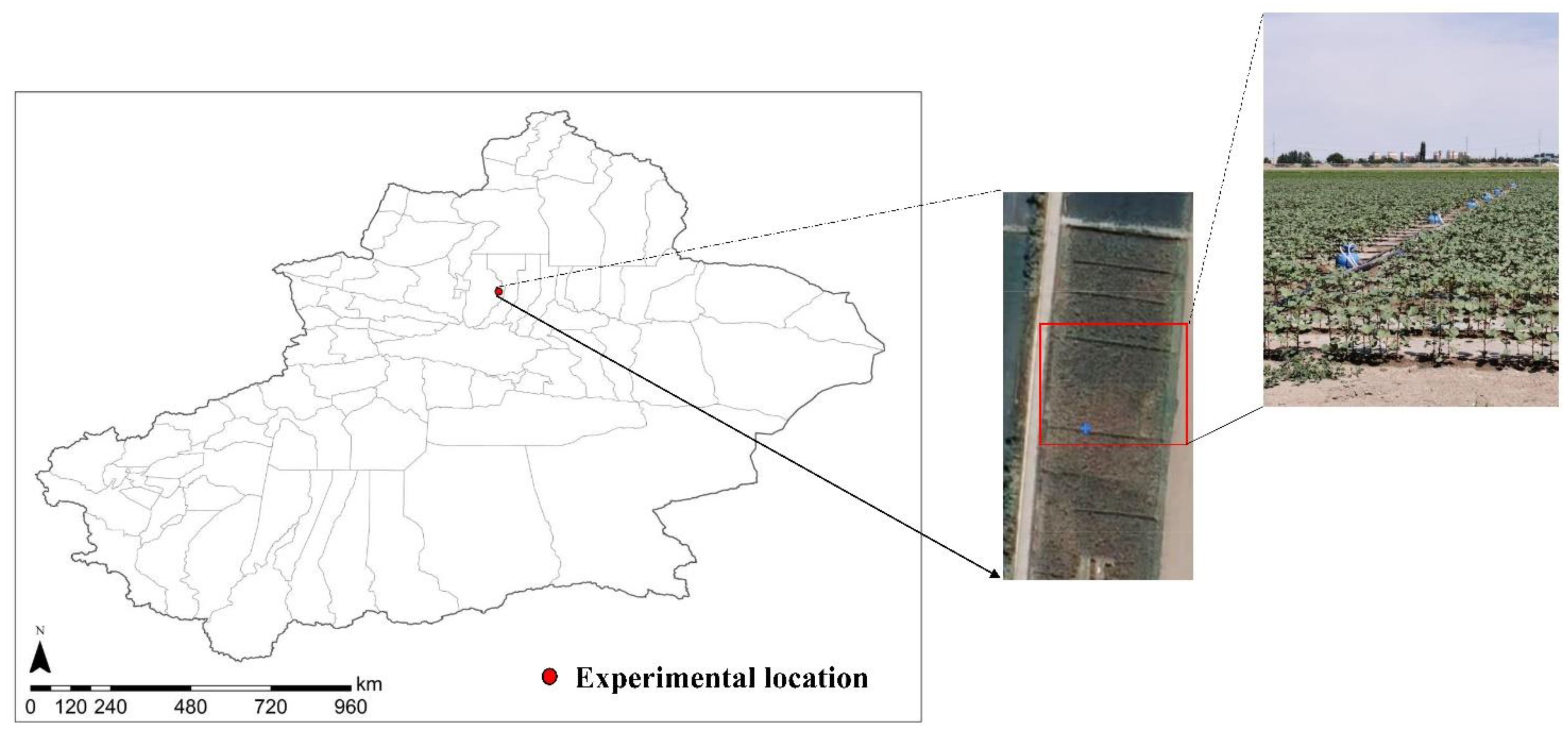
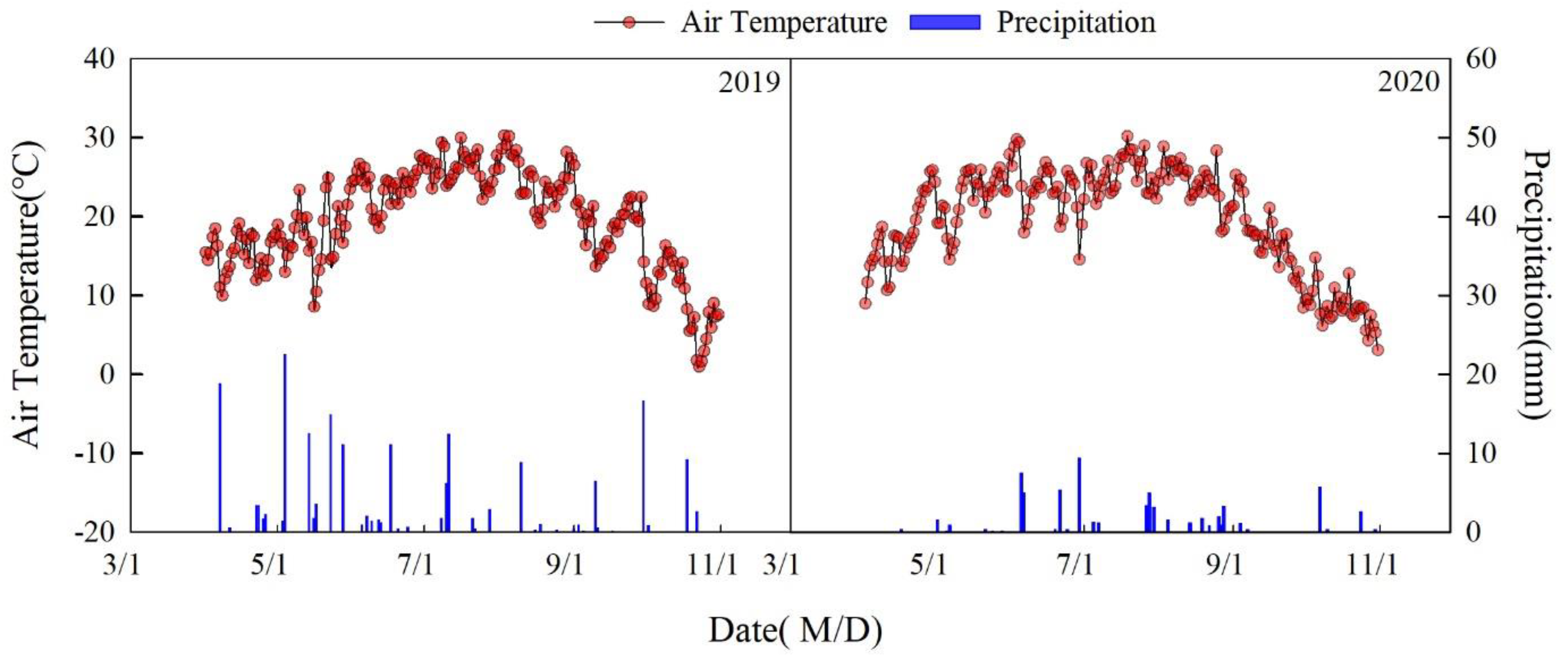
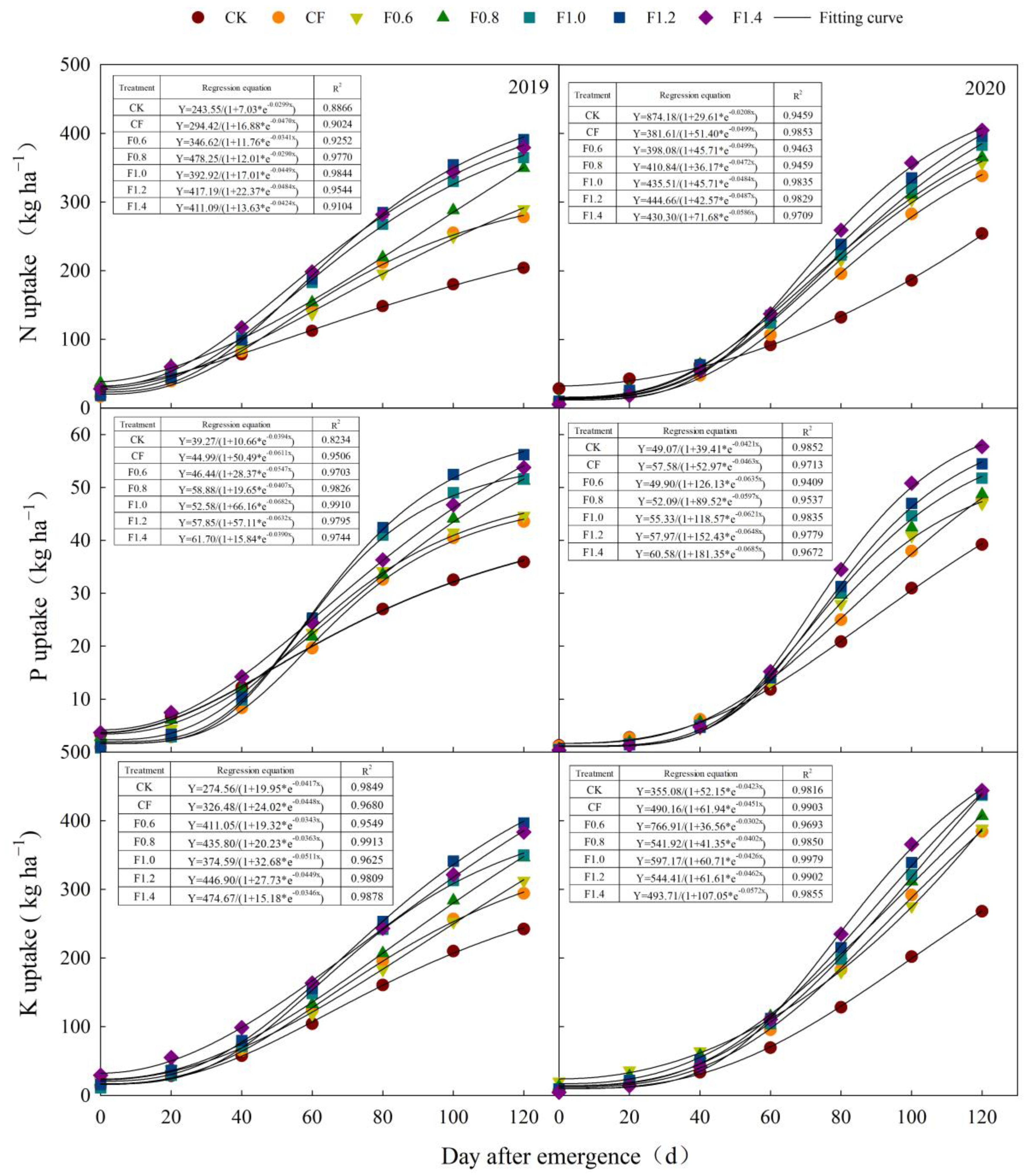
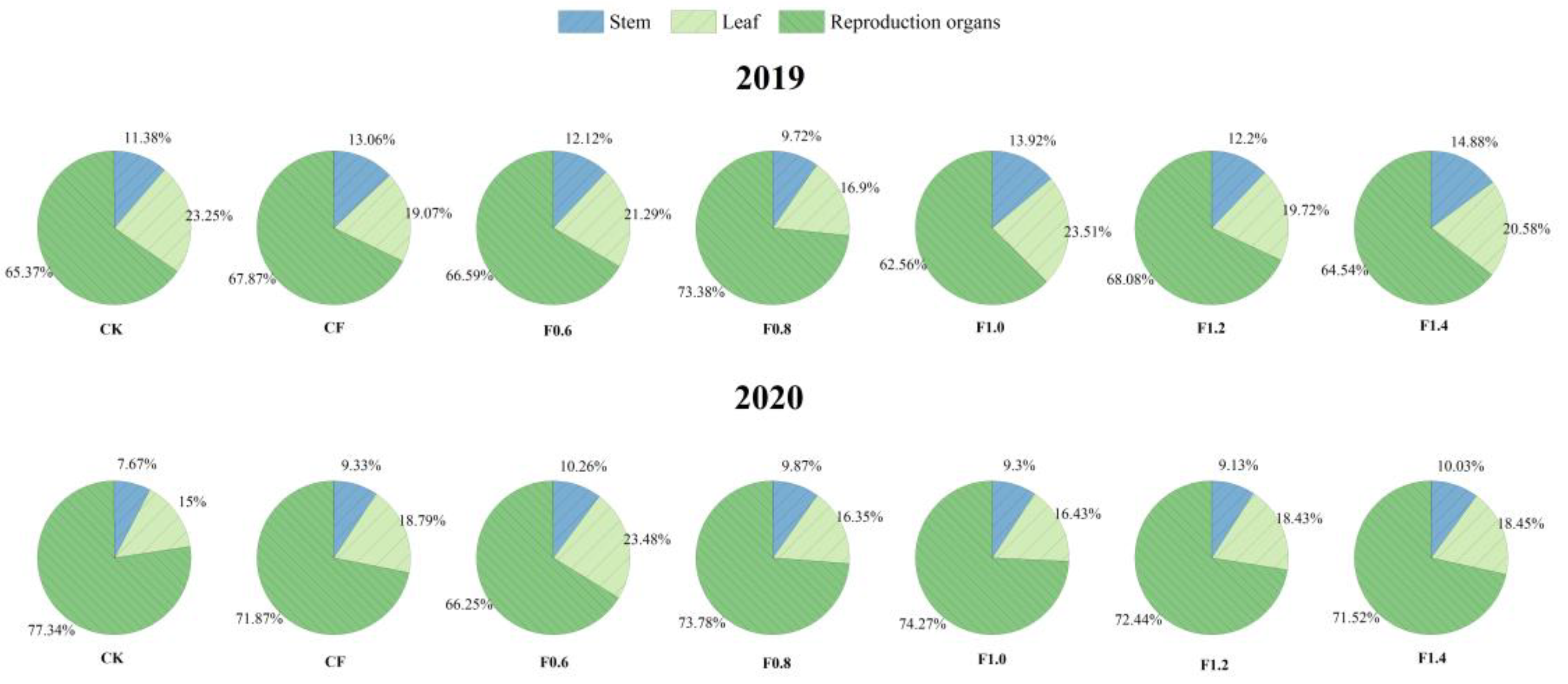

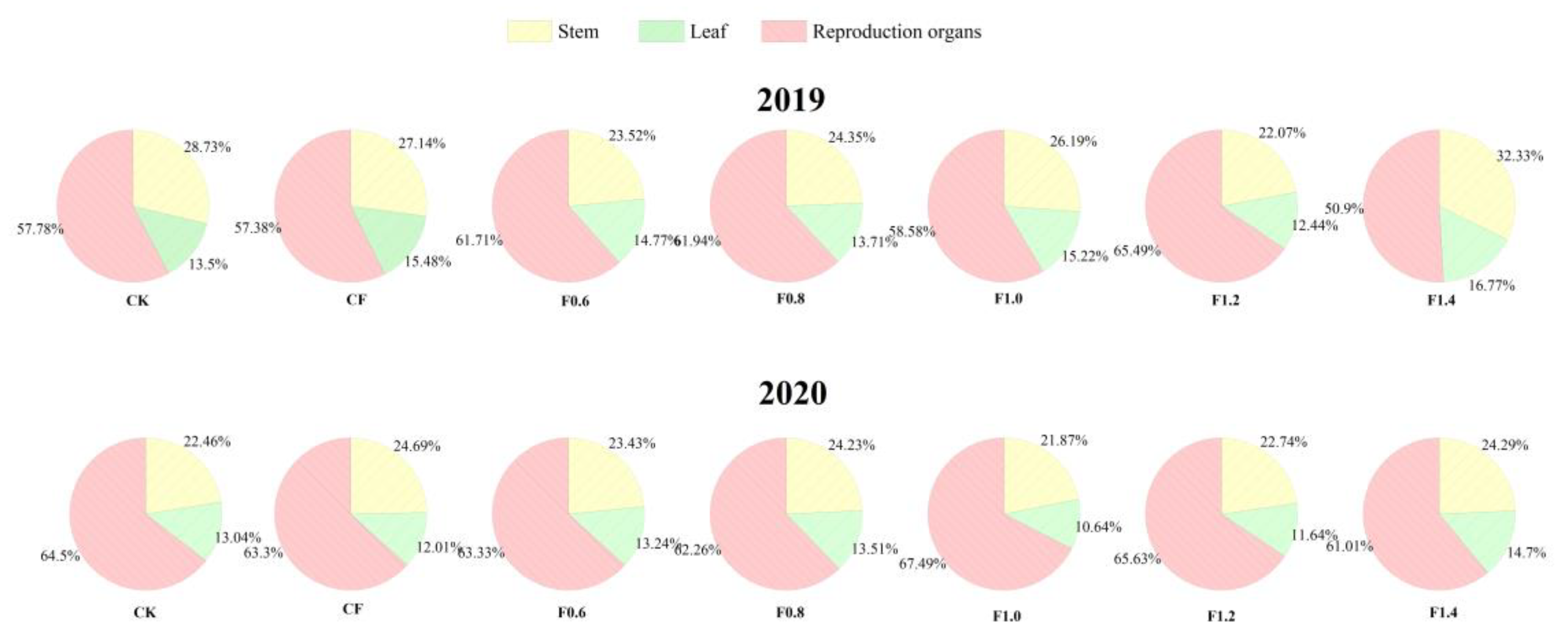

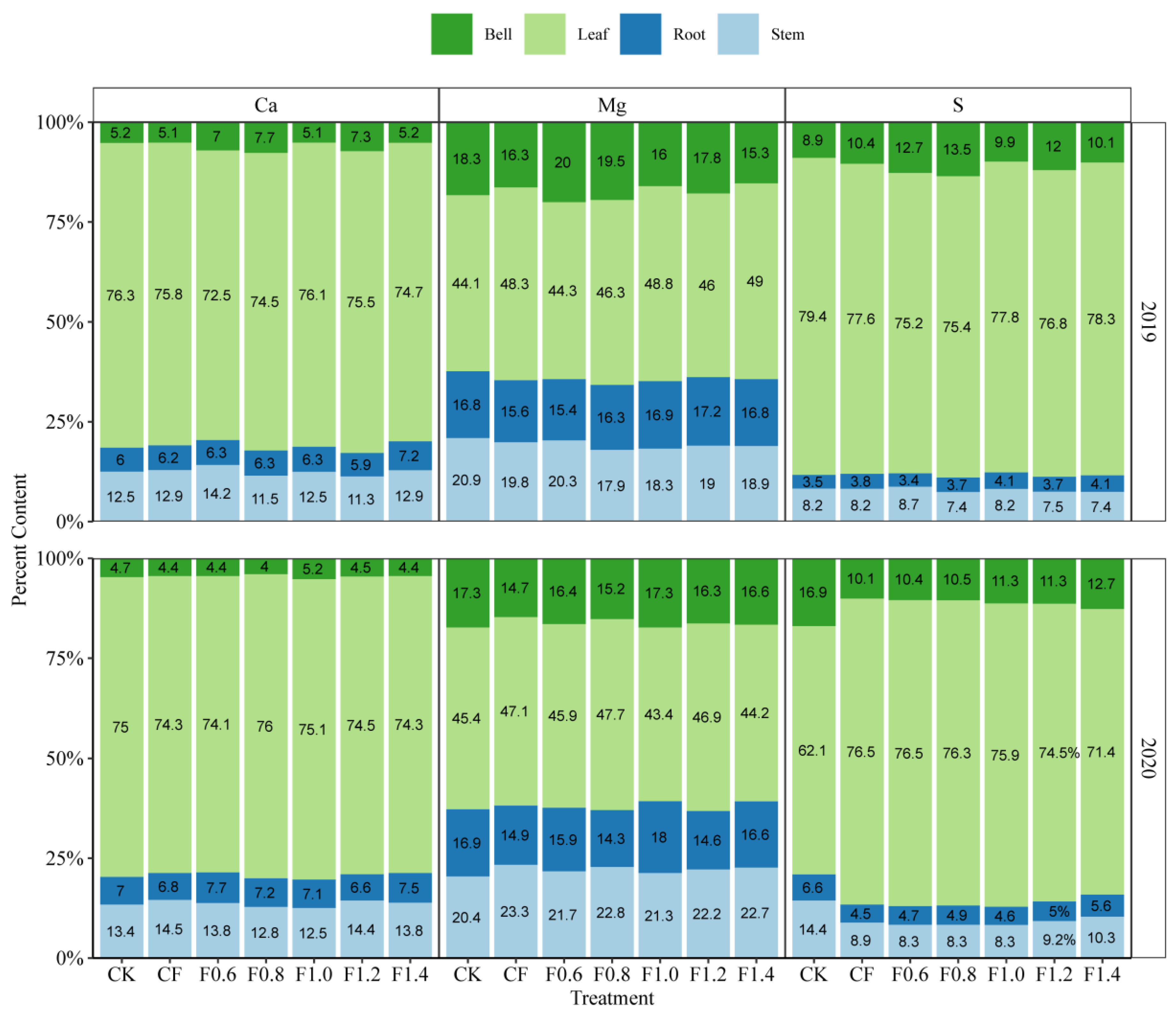

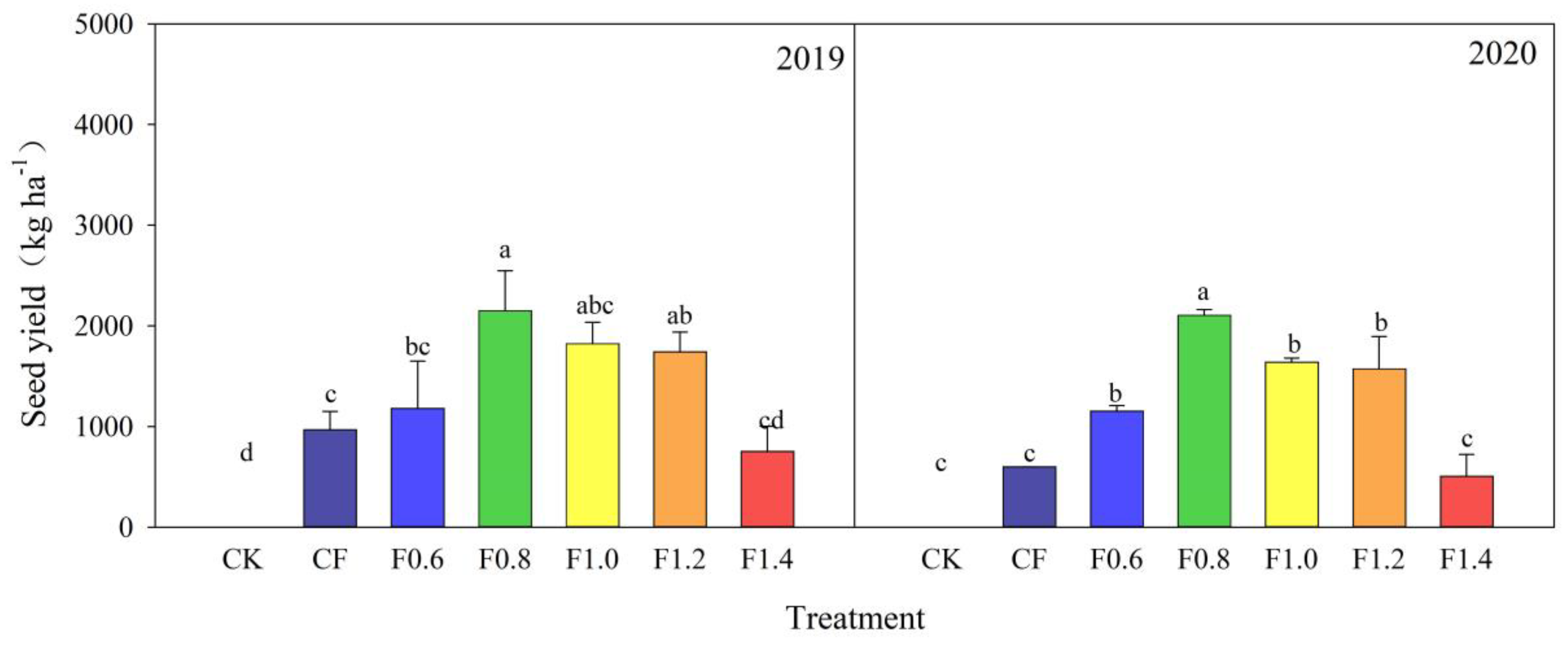
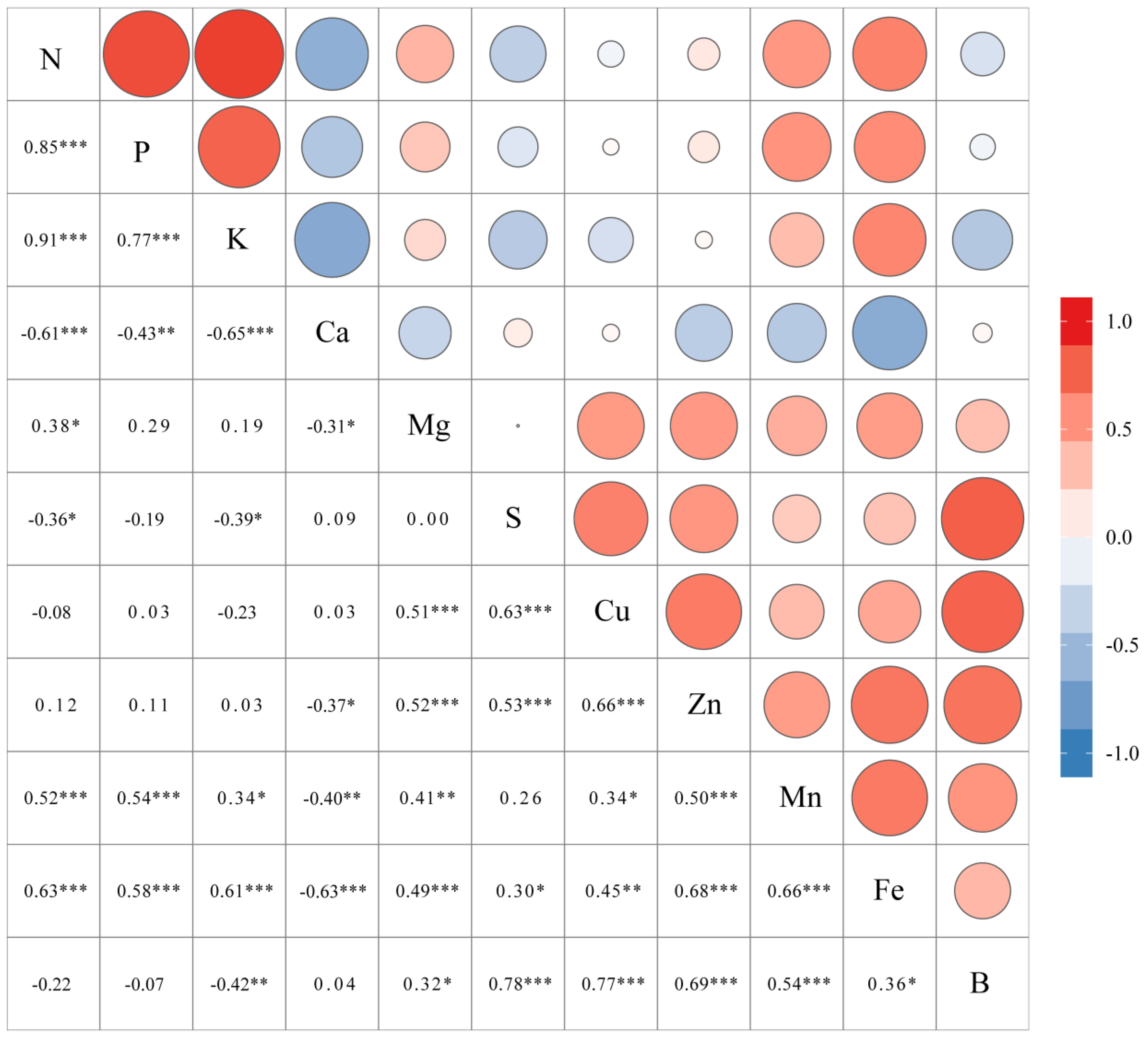

| Treatment | Fertigation | Seeding | Squaring | Flowering and Boll Setting | Total | |||||||||
|---|---|---|---|---|---|---|---|---|---|---|---|---|---|---|
| 20-April | 15-Jun | 22-Jun | 1-Jul | 9-Jul | 18-Jul | 27-Jul | 5-Aug | 13-Aug | 20-Aug | |||||
| CF | Irrigation (m3 ha−1) | 300 | 525 | 300 | 375 | 450 | 600 | 600 | 600 | 300 | 300 | 4350 | ||
| N (kg ha−1) | 9.0 | 19.8 | 24.8 | 29.7 | 28.5 | 25.7 | 24.2 | 26.4 | 23.1 | 16.5 | 228.0 | |||
| P2O5 (kg ha−1) | 4.4 | 10.8 | 13.5 | 16.2 | 18.0 | 16.2 | 15.3 | 14.4 | 12.6 | 9.0 | 131.0 | |||
| K2O (kg ha−1) | 1.5 | 5.4 | 6.8 | 8.1 | 18.0 | 16.2 | 15.3 | 9.6 | 8.4 | 6.0 | 95.0 | |||
| Irrigation (m3 ha−1) | 300 | 525 | 300 | 375 | 450 | 600 | 600 | 600 | 300 | 300 | 4350 | |||
| Organic wastewater (kg ha−1) | 46.9 | 122. 0 | 141.1 | 169.3 | 179.9 | 161.9 | 152.9 | 145.7 | 127.5 | 91.0 | 1329 | |||
| F0.6 | N (kg ha−1) | 5.4 | 11.9 | 14.9 | 17.8 | 17.1 | 15.4 | 14.5 | 15.8 | 13.9 | 9.9 | 136.8 | ||
| P2O5 (kg ha−1) | 2.7 | 6.5 | 8.1 | 9.7 | 10.8 | 9.7 | 9.2 | 8.6 | 7.6 | 5.4 | 78.6 | |||
| K2O (kg ha−1) | 0.9 | 3.2 | 4.1 | 4.9 | 10.8 | 9.7 | 9.2 | 5.8 | 5.0 | 3.6 | 57.0 | |||
| F0.8 | N (kg ha−1) | 7.2 | 15.8 | 19.8 | 23.8 | 22.8 | 20.5 | 19.4 | 21.1 | 18.5 | 13.2 | 182.4 | ||
| P2O5 (kg ha−1) | 3.6 | 8.6 | 10.8 | 13.0 | 14.4 | 13.0 | 12.2 | 11.5 | 10.1 | 7.2 | 104.8 | |||
| K2O (kg ha−1) | 1.2 | 4.3 | 5.4 | 6.5 | 14.4 | 13.0 | 12.2 | 7.7 | 6.7 | 4.8 | 76.0 | |||
| F1.0 | N (kg ha−1) | 9.0 | 19.8 | 24.8 | 29.7 | 28.5 | 25.7 | 24.2 | 26.4 | 23.1 | 16.5 | 228 | ||
| P2O5 (kg ha−1) | 4.4 | 10.8 | 13.5 | 16.2 | 18.0 | 16.2 | 15.3 | 14.4 | 12.6 | 9.0 | 131.0 | |||
| K2O (kg ha−1) | 1.5 | 5.4 | 6.8 | 8.1 | 18.0 | 16.2 | 15.3 | 9.6 | 8.4 | 6.0 | 95.0 | |||
| F1.2 | N (kg ha−1) | 10.8 | 23.8 | 29.7 | 35.6 | 34.2 | 30.8 | 29.1 | 31.7 | 27.7 | 19.8 | 273.6 | ||
| P2O5 (kg ha−1) | 5.4 | 13.0 | 16.2 | 19.4 | 21.6 | 19.4 | 18.4 | 17.3 | 15.1 | 10.8 | 157.2 | |||
| K2O (kg ha−1) | 1.8 | 6.5 | 8.1 | 9.7 | 21.6 | 19.4 | 18.4 | 11.5 | 10.1 | 7.2 | 114.0 | |||
| F1.4 | N (kg ha−1) | 12.6 | 27.7 | 34.7 | 41.6 | 39.9 | 35.9 | 33.9 | 37.0 | 32.3 | 23.1 | 319.2 | ||
| P2O5 (kg ha−1) | 6.3 | 15.1 | 18.9 | 22.7 | 25.2 | 22.7 | 21.4 | 20.2 | 17.6 | 12.6 | 183.4 | |||
| K2O (kg ha−1) | 2.1 | 7.6 | 9.5 | 11.3 | 25.2 | 22.7 | 21.4 | 13.4 | 11.8 | 8.4 | 133.0 | |||
| Organic Matter (g L−1) | Humic Acid (g L−1) | Macroelement (g L−1) | Medium Trace Element (g L−1) | pH | Liquid Densities (g mL−1) | Microbial Flora Bacillus subtilis (g L−1) | Heavy Metals (%) | ||||||||||
|---|---|---|---|---|---|---|---|---|---|---|---|---|---|---|---|---|---|
| N | P | K | Mo | B | Cu | Mn | Fe | Zn | Ca | Pb | Cd | Cr | |||||
| 208.1 | 22.1 | 23.4 | 1.7 | 56.6 | 0.08 | 0.2 | 6 × 10−8 | 0.02 | 0.1 | 0.4 | 3.3 | 7.2 | 1.21 | 2 × 10−8 | 2.5 × 10−4 | 1.8 × 10−5 | 4.7 × 10−5 |
| Treatment | Soil Organic Matter (g·kg−1) | Available Phosphorus (mg·kg−1) | Available Potassium (mg·kg−1) | Nitrate Nitrogen (mg·kg−1) | Ammonium Nitrogen (mg·kg−1) |
|---|---|---|---|---|---|
| CK | 17.1 ± 0.7 b | 14.8 ± 0.9 c | 219.1 ± 9.0 c | 0.98 ± 0.09 d | 1.18 ± 0.02 c |
| CF | 17.7 ± 0.4 b | 21.0 ± 4.0 b | 239.5 ± 6.9 b | 3.06 ± 0.19 c | 1.26 ± 0.13 c |
| F0.6 | 22.8 ± 4.0 a | 24.1 ± 2.5 ab | 270.8 ± 4.2 a | 3.28 ± 0.13 c | 1.69 ± 0.14 b |
| F0.8 | 24.6 ± 4.7 a | 24.6 ± 3.2 ab | 269.6 ± 9.5 a | 8.53 ± 0.14 b | 1.88 ± 0.07 ab |
| F1.0 | 25.0 ± 3.6 a | 25.9 ± 2.1 ab | 262.5 ± 23.7 a | 8.65 ± 1.27 b | 1.83 ± 0.07 ab |
| F1.2 | 25.8 ± 3.4 a | 27.4 ± 8.4 a | 280.0 ± 26.4 a | 8.88 ± 0.71 b | 1.74 ± 0.07 b |
| F1.4 | 26.3 ± 3.0 a | 29.3 ± 8.7 a | 259.2 ± 19.8 a | 15.07 ± 0.02 a | 1.97 ± 0.07 a |
| Year | Treatment | Cu Uptake (mg kg−1) | Zn Uptake (mg kg−1) | Mn Uptake (mg kg−1) | Fe Uptake (mg kg−1) | B Uptake (mg kg−1) |
|---|---|---|---|---|---|---|
| 2019 | CK | 12.9 ± 0.1 c | 42.9 ± 1.7 d | 98.5 ± 1.7 d | 1153.1 ± 9.9 d | 1.40 ± 0.04 f |
| CF | 14.9 ± 0.3 bc | 44.7 ± 0.6 cd | 103.2 ± 1.4 c | 1174.5 ± 4.4 c | 1.75 ± 0.01 e | |
| F0.6 | 17.7 ± 0.9 a | 50.9 ± 2.1 ab | 103.1 ± 1.9 c | 1457.4 ± 7.6 a | 2.22 ± 0.07 c | |
| F0.8 | 16.8 ± 1.5 ab | 53.6 ± 2.1 a | 159.1 ± 1.1 a | 1467.9 ± 0.7 a | 2.56 ± 0.04 a | |
| F1.0 | 16.6 ± 0.6 ab | 48.2 ± 0.9 b | 154.6 ± 1.5 b | 1427.3 ± 9.7 b | 2.54 ± 0.00 a | |
| F1.2 | 16.7 ± 2.1 ab | 47.6 ± 1.5 bc | 153.2 ± 3.1 b | 1451.2 ± 16.5 a | 2.41 ± 0.02 b | |
| F1.4 | 13.3 ± 1.0 c | 44.0 ± 1.1 c | 152.9 ± 2.3 b | 1410.4 ± 8.2 b | 2.06 ± 0.03 d | |
| 2020 | CK | 11.0 ± 0.4 b | 34.6 ± 3.3 c | 97.6 ± 2.6 c | 956.9 ± 7.7 e | 0.35 ± 0.00 f |
| CF | 13.2 ± 0.2 a | 37.0 ± 1.0 c | 119.5 ± 0.4 b | 1331.8 ± 20.9 d | 0.43 ± 0.02 e | |
| F0.6 | 13.5 ± 0.4 a | 46.8 ± 1.8 a | 126.7 ± 0.2 b | 1451.3 ± 14.7 b | 1.15 ± 0.03 a | |
| F0.8 | 13.2 ± 0.2 a | 49.0 ± 1.0 a | 141.8 ± 2.1 a | 1523.6 ± 2.4 a | 1.08 ± 0.01 b | |
| F1.0 | 13.1 ± 0.3 a | 45.3 ± 1.0 ab | 126.1 ± 2.3 b | 1480.7 ± 12.4 b | 0.78 ± 0.01 c | |
| F1.2 | 13.1 ± 1.9 a | 44.7 ± 2.1 ab | 118.9 ± 1.7 b | 1379.7 ± 23.4 c | 0.66 ± 0.03 d | |
| F1.4 | 12.8 ± 1.0 ab | 41.7 ± 1.9 b | 116.5 ± 3.4 b | 1364.9 ± 7.6 cd | 0.41 ± 0.03 e | |
| Year | * | NS | ** | NS | ** | |
| Treatment | * | ** | ** | ** | ** | |
| Treatment × Year | NS | NS | ** | ** | ** |
| Years | Treatment | NPEP (kg/kg) | NAE (kg/kg) | NUE (%) | PPEP (kg/kg) | PAE (kg/kg) | PUE (%) |
|---|---|---|---|---|---|---|---|
| 2019 | F0.6 | 43.98 ± 3.95 a | 8.64 ± 3.95 ab | 56.41 ± 5.60 c | 76.72 ± 6.88 a | 15.08 ± 6.88 ab | 9.11 ± 1.89 b |
| F0.8 | 38.31 ± 2.58 b | 11.81 ± 2.58 a | 78.84 ± 11.74 a | 66.83 ± 4.49 b | 20.60 ± 4.49 a | 14.35 ± 2.16 a | |
| F1.0 | 29.22 ± 1.25 c | 8.02 ± 1.25 ab | 72.09 ± 3.65 ab | 50.97 ± 2.18 a | 13.99 ± 2.18 ab | 11.35 ± 1.82 ab | |
| F1.2 | 24.05 ± 0.98 d | 6.38 ± 0.98 bc | 63.27 ± 6.59 bc | 41.95 ± 1.70 d | 11.13 ± 1.70 bc | 12.17 ± 2.50 ab | |
| F1.4 | 17.51 ± 1.00 e | 2.37 ± 1.00 c | 48.60 ± 5.94 c | 30.54 ± 1.75 e | 4.13 ± 1.75 c | 9.32 ± 2.20 b | |
| CF | 25.45 ± 1.12 cd | 4.25 ± 1.12 bc | 24.54 ± 2.47 d | 44.39 ± 1.96 cd | 7.41 ± 1.96 bc | 3.61 ± 0.48 c | |
| 2020 | F0.6 | 45.30 ± 0.96 a | 8.44 ± 0.96 b | 69.08 ± 6.28 a | 79.02 ± 1.68 a | 14.72 ± 1.68 b | 9.67 ± 1.43 a |
| F0.8 | 39.22 ± 0.71 b | 11.57 ± 0.71 a | 55.99 ± 10.67 a | 68.41 ± 1.23 b | 20.18 ± 1.23 a | 8.45 ± 4.86 a | |
| F1.0 | 29.32 ± 0.64 c | 7.20 ± 0.64 b | 50.51 ± 2.65 b | 51.15 ± 1.12 c | 12.57 ± 1.12 b | 8.78 ± 0.65 a | |
| F1.2 | 24.19 ± 1.87 d | 5.76 ± 1.87 b | 47.86 ± 1.14 b | 42.19 ± 3.26 d | 10.04 ± 3.26 b | 8.61 ± 1.80 a | |
| F1.4 | 17.39 ± 1.26 e | 1.59 ± 0.14 c | 43.30 ± 1.09 b | 30.33 ± 2.20 e | 2.77 ± 0.24 c | 9.59 ± 0.69 a | |
| CF | 24.76 ± 0.82 d | 2.64 ± 0.06 c | 29.35 ± 6.54 c | 43.18 ± 1.43 d | 4.60 ± 0.11 c | 6.86 ± 3.46 a | |
| Treatment | ** | * | * | ** | * | NS | |
| Year | NS | NS | NS | NS | NS | NS | |
| Treatment×Year | NS | NS | NS | NS | NS | NS |
Publisher’s Note: MDPI stays neutral with regard to jurisdictional claims in published maps and institutional affiliations. |
© 2022 by the authors. Licensee MDPI, Basel, Switzerland. This article is an open access article distributed under the terms and conditions of the Creative Commons Attribution (CC BY) license (https://creativecommons.org/licenses/by/4.0/).
Share and Cite
Hao, X.; Shi, X.; Khan, A.; Li, N.; Shi, F.; Li, J.; Tian, Y.; Han, P.; Wang, J.; Luo, H. Industrial Organic Wastewater through Drip Irrigation to Reduce Chemical Fertilizer Input and Increase Use Efficiency by Promoting N and P Absorption of Cotton in Arid Areas. Agriculture 2022, 12, 2007. https://doi.org/10.3390/agriculture12122007
Hao X, Shi X, Khan A, Li N, Shi F, Li J, Tian Y, Han P, Wang J, Luo H. Industrial Organic Wastewater through Drip Irrigation to Reduce Chemical Fertilizer Input and Increase Use Efficiency by Promoting N and P Absorption of Cotton in Arid Areas. Agriculture. 2022; 12(12):2007. https://doi.org/10.3390/agriculture12122007
Chicago/Turabian StyleHao, Xianzhe, Xiaojuan Shi, Aziz Khan, Nannan Li, Feng Shi, Junhong Li, Yu Tian, Peng Han, Jun Wang, and Honghai Luo. 2022. "Industrial Organic Wastewater through Drip Irrigation to Reduce Chemical Fertilizer Input and Increase Use Efficiency by Promoting N and P Absorption of Cotton in Arid Areas" Agriculture 12, no. 12: 2007. https://doi.org/10.3390/agriculture12122007
APA StyleHao, X., Shi, X., Khan, A., Li, N., Shi, F., Li, J., Tian, Y., Han, P., Wang, J., & Luo, H. (2022). Industrial Organic Wastewater through Drip Irrigation to Reduce Chemical Fertilizer Input and Increase Use Efficiency by Promoting N and P Absorption of Cotton in Arid Areas. Agriculture, 12(12), 2007. https://doi.org/10.3390/agriculture12122007







